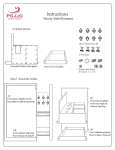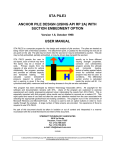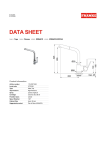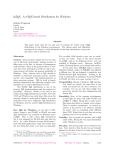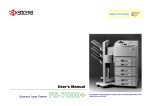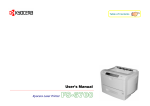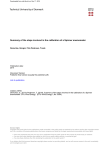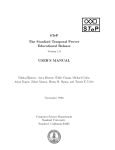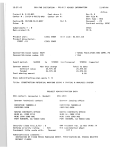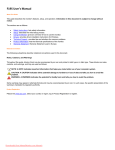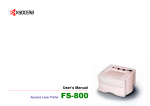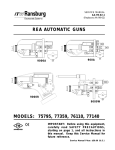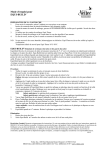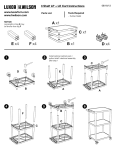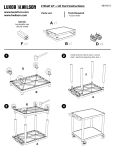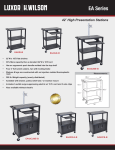Download STAPullout - Stewart Technology Associates
Transcript
STA PULLOUT User Manual January 29, 1999 Page i STA PULLOUT ANCHOR PLATE PULLOUT RESISTANCE Version 1.1, January 1999 USER MANUAL STA PULLOUT is a computer program for the design and analysis of plate anchors. The program does not consider how the plate may have been embedded. The pulling line attachment is assumed to be arranged such that the line pull is perpendicular to the plate and the pulling force is directly above the plate center of area. STA PULLOUT permits the user to specify up to three different soil layers, each of which may have varying strength properties. The layers may be a mixture of cohesive and cohesionless soils. Primary results from the program provide the ultimate capacity of plate anchors for vertical pullout resistance. The program provides factors of safety against failure for short term and long term loading. Resistance to dynamic loading is also accounted for. This program has been developed by Stewart Technology Associates (STA). All copyright for the software and documentation remains with STA. Users of the program are cautioned to exercise experienced and careful engineering judgment when interpreting the results from STA PULLOUT. This is especially important with this program, since results can be obtained in seconds on a modern PC. This rapid speed and ease of use does not alter the care and attention needed from the user associated with selecting the appropriate geotechnical and loading conditions. The program runs in the environment of Microsoft Windows and Microsoft Excel. A mouse is used to click on option buttons in order to move rapidly through the analysis. A large number of Help screens are provided. No experience of Excel is required to use STA PULLOUT. No part of this document should be taken in isolation or out of context and interpreted in a manner inconsistent with the overall framework and intent of this document. STEWART TECHNOLOGY ASSOCIATES 5619 Val Verde Houston, Texas 77057 Tel: (713) 789-8341 Fax: (713) 789-0314 e-mail: [email protected] 10/29/98 C:\Documents and Settings\Lucy.HAL-9000A\My Documents\My Web Sites\stewart-usa.com\www\STAPullout.doc STA PULLOUT User Manual January 29, 1999 Page ii EXTRACTS FROM LICENSE AGREEMENT 1. This License is granted to the USER for an indefinite period. The USER agrees that no individual, outside consultant, government organization, or any person who is not on permanent staff with the USER or under direct in-house control of USER shall have access to the PROGRAM or shall use the PROGRAM for any purpose at any time. The use of the PROGRAM is not limited to a single machine, and the USER may make copies of PROGRAM and run it on several machines simultaneously. The USER agrees to make any reasonable effort to assure that the PROGRAM file or disk is not copied without authorization by OWNER, and that all users in USER's organization are familiar with these Limitations of Use. The USER agrees not to modify, copy, sell, lease, rent, give free of charge, or otherwise distribute or alter the PROGRAM or any part thereof to any individual, government agency, or organization outside of the USER organization. 2. All copyrights to the PROGRAM are reserved by OWNER. All versions of the PROGRAM are copyrighted by OWNER worldwide, beginning with 1991. The following is a trademark of OWNER: STA PULLOUT. The USER shall clearly and distinctly indicate the copyright in all published and public references to the PROGRAM. The USER will abide by the Copyright Law of the United States, with the exception that the USER can make as many copies of the PROGRAM as deemed necessary by the USER and may run the PROGRAM simultaneously on as many computers as deemed necessary by the USER. 5. The USER will not prepare derivative works based on the PROGRAM provided under this agreement without acknowledging Stewart Technology Associates (STA) as the original authors of the PROGRAM. The USER will provide copies of any derivative works to STA within one month of the USER completing any such derivative works. 4. The OWNER will attempt to diagnose any problems associated with a defective diskette or a fault found in the program. If a fault is thought to exist by the USER within the PROGRAM, the OWNER will attempt to rectify the problem upon receipt of a full written explanation of the fault from the USER. 5. While the OWNER has carefully developed the PROGRAM and the PROGRAM has been tested for accuracy and proper functioning, nevertheless the OWNER cannot guarantee its accuracy and correctness. If the PROGRAM fails to perform correctly as a result of errors or omissions by the OWNER or its staff, the OWNER will, at its discretion, rectify those errors and omissions free of all charges to the USER. This shall be the limit of the OWNER's liability in this respect. The OWNER warrants that it has the right to grant this license. The PROGRAM and its documentation are sold "as is," and the USER assumes the entire risk as to quality and performance. 6. The cost for this PROGRAM is $xxx, including a single user manual. The PROGRAM may be used on a network. 7. Support services from Stewart Technology Associates for the use of the PROGRAM are included in the purchase price of the original copy of the PROGRAM. These support services are for a total period of xxx hours total consultancy time. If additional services are required beyond the xxx hours noted above, such services will be charged at the rate of $xxx per hour. 8. The OWNER shall not be liable to the USER or any other party for any design, performance or other fault or inadequacy of the PROGRAM or its manual, or for any direct or implied damages of any kind arising out of or in any way related to or connected with any use of the PROGRAM. C:\Documents and Settings\Lucy.HAL-9000A\My Documents\My Web Sites\stewart-usa.com\www\STAPullout.doc STA PULLOUT User Manual January 29, 1999 Page iii CONTENTS LIST Subject Page # 1.0 INTRODUCTION .................................................................................................. 1 2.0 FAILURE MECHANISM........................................................................................ 2 3.0 PROGRAM INSTALLATION................................................................................. 3 4.0 HARDWARE REQUIREMENTS AND PRINTING................................................. 5 5.0 RUNNING THE PROGRAM ................................................................................. 7 6.0 GETTING HELP ................................................................................................... 8 7.0 BASIC ANALYSIS ASSUMPTIONS.................................................................... 10 8.0 RESULTS ........................................................................................................... 12 REFERENCES .............................................................................................................. 13 APPENDIX 1 .....................................................................DEFINITION OF INPUT DATA C:\Documents and Settings\Lucy.HAL-9000A\My Documents\My Web Sites\stewart-usa.com\www\STAPullout.doc STA PULLOUT, VERSION 1.1, February 1999 1.0 PAGE 1 INTRODUCTION STA PULLOUT is a computer program for the design and analysis of plate anchors. The program does not consider how the plate may have been embedded. The original application was developed for marine plate anchors embedded in the seabed and loaded vertically. STA PULLOUT can be used to estimate the maximum force needed to recover a drag embedment anchor. The program has also been used to solve onshore problems. STA PULLOUT permits the user to specify up to three different soil layers, each of which may have varying strength properties. The layers may be a mixture of cohesive and cohesionless soils. Primary results from the program provide the ultimate capacity of plate anchors for vertical pullout resistance. The program provides factors of safety against failure for short term and long term loading. Resistance to dynamic loading is also accounted for. C:\Documents and Settings\Lucy.HAL-9000A\My Documents\My Web Sites\stewart-usa.com\www\STAPullout.doc STA PULLOUT, VERSION 1.1, February 1999 2.0 PAGE 2 FAILURE MECHANISM Two general failure mechanisms are assumed by the program: shallow failure and deep failure. These failure mechanisms are illustrated in Figure 1 below. FIGURE 1 When computing plate pullout resistance, STA PULLOUT adjusts the bearing capacity factors accounting for plate geometry, plate burial depth and soil properties. C:\Documents and Settings\Lucy.HAL-9000A\My Documents\My Web Sites\stewart-usa.com\www\STAPullout.doc STA PULLOUT, VERSION 1.1, February 1999 3.0 PROGRAM INSTALLATION 3.1 Introduction PAGE 3 STA PULLOUT is a computer program for the design and analysis of pile anchors. The latest release of the program (Version 1.5, October 1998) runs in the environment of Microsoft Excel 97, or later, under Windows 95, NT4, or later. The program is distributed as a series of Excel workbook with macro files on a single 3.5 inch floppy disk. This section of the manual provides instructions for loading the program and setting up the Windows icon. 3.2 Install Files and Create Directories STA PULLOUT must be set up in sub-directory on your hard disk. Before installing STA PULLOUT, you must have Excel already installed on your hard disk. You must manually set up the necessary directory and copy the files over. The manual procedure is as follows: Create a sub-directory, for example, called STAPULLOUT. All files from the floppy disk should be copied into the STAPULLOUT sub-directory. You will then have a path to the program files as shown below: X:\MY_PROJECTS/STAPULLOUT/program_files In the example above, X: is the name of your hard disk (most likely this will be C: or D:) and the MY_PROJECTS directory may be where you store your projects. 3.3 Install Icon Once the directory structure has been created and the program files have been copied from the distribution floppy diskette to the STAPULLOUT sub-directory, you can set up the icon (see your Windows documentation, or simply right-click on your desktop and be intuitive). 3.4 Program Files On Distribution Diskettes Each distribution diskette for STA PULLOUT is a self-contained version of the program. The files on your diskette should be as listed below. C:\Documents and Settings\Lucy.HAL-9000A\My Documents\My Web Sites\stewart-usa.com\www\STAPullout.doc STA PULLOUT, VERSION 1.1, February 1999 File Name STAPULLOUT.ICO STAPULLOUT.XLS PAGE 4 Description Icon for STA PULLOUT. The icon is displayed by Windows. Double click on the icon to start STA PULLOUT after program is installed. This is the main file displayed to the user by Excel. All the data input is specified in this file. All principle results are contained in this file. Other files may be present on your diskette, and the names of some of the above files may be changed slightly on some diskettes. The STA PULLOUT icon is shown to the right. C:\Documents and Settings\Lucy.HAL-9000A\My Documents\My Web Sites\stewart-usa.com\www\STAPullout.doc STA PULLOUT, VERSION 1.1, February 1999 4.0 PAGE 5 HARDWARE REQUIREMENTS AND PRINTING STA PULLOUT requires an IBM PC with Microsoft Excel 67 or later, running under Microsoft Windows 95 or later environment. Program output has been customized such that it prints all principal input and output on one page as shown in Figure 2, on the following page. For best quality print, it is recommended that a color ink jet printer be used with a minimum resolution of 300 dpi. Significantly better quality will be obtained with a dot resolution of 400 dpi or above. True Type fonts have been used throughout the worksheet. Almost all the fonts are Arial. Many of the fonts are Arial Narrow. If you do not have these fonts on your machine, the program will select the nearest font style. It is recommended that you obtain the Arial Narrow font if it is not currently available on your system. You may elect to print any of the output in color, for example on a HP Deskjet printer. If a color printer is used, you may have to disable certain third party fontware, such as Adobe Type Manager, in order to get color text and numbers to print. However, once your printer is set up to print any other spreadsheets from Excel, you should have no problem in printing output from STA PULLOUT. You may have a higher resolution screen driver (than VGA, which is the minimum required for STA PULLOUT) in use on your system. This will be advantageous in that it allows you to see more of the main worksheet than you can see with a VGA driver. Most of the examples in this manual show screens with an 800 x 600 screen driver. C:\Documents and Settings\Lucy.HAL-9000A\My Documents\My Web Sites\stewart-usa.com\www\STAPullout.doc STA PULLOUT, VERSION 1.1, February 1999 STA PULLOUT PAGE 6 Anchor Vertical Pullout Resistance v.1.0 May 1993 Run ref: Example For User Manual 2/8/99 9:11 Copyright Stewart Technology Associates 1993. For support telephone: (713) 665-7294, or fax: (713) 665-1424 Assumptions Explain Permeability & Plasticity for Cyclic Loading Print this screen INPUT DATA BELOW SOIL PROPERTIES ANCHOR PROPERTIES & ANALYSIS CONTROL 100.00 Z1, thickness of upper soil layer (ft) 7.00 fluke length (ft) 0.8 Strength reduction factor 7.00 fluke width (ft) 200 av.static uplift load (kips) 44.10 fluke area (sqft) 77 dynamic load double amp. (kips) 140.00 burial depth (ft) 2 1=cohesionless, 2=cohesive 1 1=normal, 2=delta mud 50.00 Z2, thickness of middle soil layer (ft) 5.00 Z3, thickness of lowest soil layer (ft) 35.00 cu1, undrained sh. strength top 1st layer (psf) 835.00 cu2, undrained sh. strength bottom 1st layer (psf) 12.00 storm duration (hours) 885.00 cu3, undrained sh. strength top 2nd layer (psf) 12.00 av.wave period (sec) 910.00 cu4, undrained sh. strength bottom 2nd layer (psf) Soil Shear Strength Profile 910.00 cu5, undrained sh. strength top 3rd layer (psf) 920.00 cu6, undrained sh. strength bottom 3rd layer (psf) 0.00 22.00 drained friction angle 1st layer (deg) -20.00 32.00 drained friction angle 3rd layer (deg) -40.00 35.00 Gamma1, 1st layer buoyant weight (pcf) -60.00 73.00 Gamma2, 2nd layer buoyant weight (pcf) 30.00 Gamma3, 3rd layer buoyant weight (pcf) 0 ratio of drained/undrained soil cohesion Results Short-term ultimate capacity (kips) Long-term ultimate capacity (kips) Static short-term safety factor Static long-term safety factor Holding Capacity Factors at Anchor 479 479 2.39 2.39 depth in feet 27.00 drained friction angle 2nd layer (deg) -80.00 -100.00 -120.00 anchor -140.00 -160.00 -180.00 0 200 400 600 800 undrained shear strength in psf 15.00 Ncs short-term (calculated) 9.50 Nc long-term (calculated) 8.37 Nq cohesionless (calculated) Dynamic Loading Parameters 0.003 estimated soil permeability (ft/sec) 0 time reqd.for pore press.dissipation (days) 2.63 dynamic load range safety factor (single storm) 202 maximum dynamic load range for single storm (kips) 12 number of loading cycles in single storm FIGURE 2 C:\Documents and Settings\Lucy.HAL-9000A\My Documents\My Web Sites\stewart-usa.com\www\STAPullout.doc 1000 STA PULLOUT, VERSION 1.1, February 1999 5.0 PAGE 7 RUNNING THE PROGRAM Once you have set up the program using the instructions in Section 4.0, you will be able to click on the STAPULLOUT icon to start Excel and STA PULLOUT. The main spreadsheet (STAPULLOUT.XLS) will load. You may need to maximize the spreadsheet. Do this by clicking once on the middle symbol in the upper right hand corner of the spreadsheet as shown in the figure on the right. The spreadsheet will always contain values in every editable cell. It is recommended that following an analysis with the program, you save the spreadsheet before closing down the application. You may also want to set Excel calculations to automatic. You do this through the Tools, Options, menus. C:\Documents and Settings\Lucy.HAL-9000A\My Documents\My Web Sites\stewart-usa.com\www\STAPullout.doc STA PULLOUT, VERSION 1.1, February 1999 6.0 PAGE 8 GETTING HELP In Figure 2, two of the buttons are labeled Explain . Highlight any data entry or results cell (by clicking on it once) and then click once on any Explain button. A dialog box will be flashed up onto the screen containing information regarding the selected cell. An example of this is shown in Figure 3. In this figure, the user has selected the input cell strength reduction factor. A dialog box has been brought up onto the screen describing what this input data does. FIGURE 3 Help is also available in interpreting the results. The main summary results for an installed pile analysis are seen in the lower right hand corner of Figure 2. If the user selects a cell for which there is no help available, a dialog box will be flashed up on the screen, suggesting that the cursor be repositioned in another cell. An example of this is shown in Figure 4. C:\Documents and Settings\Lucy.HAL-9000A\My Documents\My Web Sites\stewart-usa.com\www\STAPullout.doc STA PULLOUT, VERSION 1.1, February 1999 PAGE 9 FIGURE 4 C:\Documents and Settings\Lucy.HAL-9000A\My Documents\My Web Sites\stewart-usa.com\www\STAPullout.doc STA PULLOUT, VERSION 1.1, February 1999 7.0 PAGE 10 BASIC ANALYSIS ASSUMPTIONS The user can be reminded of the basic analysis assumptions when running the program by clicking once on the button assumptions. STA PULLOUT uses the geotechnical formulae and nomenclature of the NCEL Geotechnical Handbook. The user should have the Handbook at the ready when using the program, especially if the dynamic soil properties are of interest. 7.1 Permeability and Plasticity for Cyclic Loading In accordance with the procedures in the NCEL Geotechnical Handbook, the user can select a soil characterization from the dialog box shown in Figure 5. This box appears when the button Permeability and Plasticity for Cyclic Loading is clicked. FIGURE 5 After selecting one of the soil types, click OK and the program will display the dialog box shown in Figure 6, indicating the maximum soil cyclic load capacity without causing soil loss of strength. C:\Documents and Settings\Lucy.HAL-9000A\My Documents\My Web Sites\stewart-usa.com\www\STAPullout.doc STA PULLOUT, VERSION 1.1, February 1999 PAGE 11 FIGURE 6 Layered Soils Up to three soil the user in STA PULLOUT can specify layers which may be mixed cohesive and cohesionless layers. In each layer, the above equations are implemented for each elemental length of the pile. Overburden pressure is calculated for buried cohesionless layers. C:\Documents and Settings\Lucy.HAL-9000A\My Documents\My Web Sites\stewart-usa.com\www\STAPullout.doc STA PULLOUT, VERSION 1.1, February 1999 8.0 PAGE 12 RESULTS The pullout resistance results are shown in the bottom left hand corner of Figure 2. A larger view is shown in Figures 7 and 8. Results 2370 Capacity in cohesionless soil (kips) cohesionless soil selected 11.85 Static short-term safety factor FIGURE 7 Results 479 479 2.39 2.39 Short-term ultimate capacity (kips) Long-term ultimate capacity (kips) Static short-term safety factor Static long-term safety factor FIGURE 8 Results in Figure 7 are for a cohesionless soil. Results in Figure 8 are for a cohesive soil. C:\Documents and Settings\Lucy.HAL-9000A\My Documents\My Web Sites\stewart-usa.com\www\STAPullout.doc STA PULLOUT, VERSION 1.1, February 1999 PAGE 13 REFERENCES 1. "Handbook For Marine Geotechnical Engineering", Technical Editor, Rocker, K. March 1985, available from Naval Civil Engineering Laboratory Port Hueneme, California 93043. C:\Documents and Settings\Lucy.HAL-9000A\My Documents\My Web Sites\stewart-usa.com\www\STAPullout.doc STA PULLOUT, VERSION 1.1, February 1999 Appendix 1 - PAGE 1 APPENDIX 1 DEFINITION OF INPUT DATA This Appendix lists each of the input data terms that the user may edit. Note that by placing the cursor on any input data cell and clicking on the button, EXPLAIN VALUE, the User is presented with a dialog box containing a detailed description of the input data term. This Appendix provides a reference for each of these terms. C:\Documents and Settings\Lucy.HAL-9000A\My Documents\My Web Sites\stewart-usa.com\www\STAPullout.doc STA PULLOUT, VERSION 1.1, February 1999 Appendix 1 - PAGE 2 Z1, thickness of upper soil layer (ft) This is the thickness of the first soil layer from the sea bed downwards. Units are feet. Z2, thickness of middle soil layer (ft) This is the thickness of the second soil layer beneath the seabed. Units are feet. Note that a visual check on the input data is provided in the upper diagram on the main results page for the program entitled, Soil Shear Strength Profile. Z3, thickness of lowest soil layer, (ft) This is the thickness of the lowest soil layer in the analysis. Units are feet. Note that if the plate is defined as being embedded to a depth within the sea bed beneath the bottom of this lowest soil layer, the properties for the soil at the bottom of the layer will be extended to the plate location. Phi1, 1st layer friction angle (deg.) This is the friction angle to be used in the analysis for cohesionless soil in the first layer. Units are degrees. If the first soil layer is cohesive, Phi1 should be specified as zero. The program will issue a warning if both cohesive and cohesionless properties are specified for any soil layer. Phi2, 2nd layer friction angle (deg.) This is the friction angle to be used in the analysis for the second soil layer. Comments as for Phi1 apply. Phi3, 3rd layer friction angle (deg.) This is the third layer friction angle. Comments as for Phi1 apply. cu1, undrained sh. strength top 1st layer (psf) This is the UNDISTURBED undrained shear strength for the soil at the top of the first layer, in other words, at the seabed. Units are in pounds force per square foot. cu2, undrained sh. strength bottom 1st layer (psf) This is the UNDISTURBED undrained shear strength for the soil at the bottom of the first layer, in other words, at the seabed. Units are in pounds force per square foot. The undrained shear strength is considered to vary in a linear manner between the top and bottom of each layer. cu3, undrained sh. strength top 2nd layer (psf) This is the undrained shear strength for the soil at the top of the second layer, in other words, at the seabed. Units are in pounds force per square foot. cu4, undrained sh. strength bottom 2nd layer (psf) Comments as for cu2 apply. cu5, undrained sh. strength top 3rd layer (psf) Comments as for cu1 apply. C:\Documents and Settings\Lucy.HAL-9000A\My Documents\My Web Sites\stewart-usa.com\www\STAPullout.doc STA PULLOUT, VERSION 1.1, February 1999 Appendix 1 - PAGE 3 cu6, undrained sh. strength bottom 3rd layer (psf) Comments as for cu2 apply. Note that if the pile is specified as being embedded with its bottom beneath the third soil layer, the soil strength and weight parameters at the bottom of the third layer will be continued downwards. Gamma1, 1st layer buoyant weight (pcf) This is the submerged, or buoyant weight of the soil in the first layer. Units are in pounds per cubic foot. Gamma2, 2nd layer buoyant weight (pcf) This is the submerged, or buoyant weight of the soil in the second layer. Units are in pounds per cubic foot. Gamma3, 3rd layer buoyant weight (pcf) This is the submerged, or buoyant weight of the soil in the third layer. Units are in pounds per cubic foot. fluke length (ft) This is the maximum length of the plate fluke width (ft) This is the maximum width of the plate Fluke area (sqft) This is the actual area of the plate and does not have to be equal to the length times the width as the plate does not have to be rectangular. Burial Depth (ft) The depth beneath the seabed where the plate is located. If a keying operation is to take place, as with a driven plate anchor, this should be the depth after keying. Storm duration (hours) If dynamic information on plate behavior is required, this is the duration of a design storm. Av.wave period (sec) If dynamic information on plate behavior is required, this is average period of the waves in the design storm and can be set equal to the average zero-crossing period. Strength reduction factor This term is used to multiply the undisturbed undrained shear strength of each layer. A reduction factor of 0.5 means that the actual undrained strength of the soil used in resistance and pullout calculations will be 50% of that input by the User. A reduction factor of 0.75 means that the actual undrained shear strength of the soil will be 75% of that specified by the User. C:\Documents and Settings\Lucy.HAL-9000A\My Documents\My Web Sites\stewart-usa.com\www\STAPullout.doc STA PULLOUT, VERSION 1.1, February 1999 Appendix 1 - PAGE 4 Av.static uplift load (kips) This is the design load required by the user. If dynamic loads are also considered, this should be the average load, normally equal to the static component only. Dynamic load double amp. (kips) If dynamic loading is considered this should generally be equal to the significant load in a storm. More conservatively, it can be set equal to the maximum anticipated load. 1=cohesionless, 2=cohesive This is a switch that must be set by the user. If all layers are cohesionless select 1. Otherwise select 2 and use the long-term pullout resistance results if the plate is in a cohesionless layer. 1=normal, 2=delta mud This is a switch that must be set by the user. The switch function is explained below. C:\Documents and Settings\Lucy.HAL-9000A\My Documents\My Web Sites\stewart-usa.com\www\STAPullout.doc




















